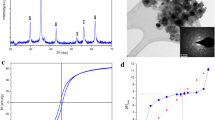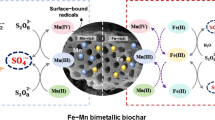Abstract
Natural organic matter (NOM) can affect arsenic speciation and mobility in the environment. In this study, the effects of NOM on the coprecipitation of arsenic with iron were investigated in order to better understand the fate and transport of arsenic in natural environments. The coprecipitation of arsenic with iron was studied in the presence and absence of NOM under various arsenic-to-iron molar ratios (As/Fe) and pH conditions. The addition of humic acid (HA) hindered the As–Fe coprecipitation under high pH and high As/Fe conditions by forming a soluble As–Fe–HA complex. The X-ray diffraction and Fourier transform infrared studies showed that the As–Fe-coprecipitated solid phase was highly affected by pH and As/Fe. The arsenic was coprecipitated with iron as an amorphous ferric arsenate phase at a low pH level or high As/Fe conditions, while the formation of ferrihydrite phase and the arsenic incorporation to the ferrihydrite by adsorption was predominant at high pH levels or low As/Fe conditions. The HA affected the As–Fe-coprecipitated solid phase depending on the As/Fe molar ratio under neutral and alkaline conditions.








Similar content being viewed by others
References
Chen, Z., Cai, Y., Solo-Gabriele, H., Snyder, G. H., & Cisar, J. L. (2006). Interactions of arsenic and the dissolved substances derived from turf soils. Envionmental Science & Technology, 40, 4659–4665.
Deng, Y., & Dixon, J. B. (2002). Soil organic matter and organic-mineral interactions. In J. B. Dixon & D. G. Schulze (Eds.), Soil mineralogy with environmental applications (Vol. 3). Madison, WI: Soil Science Society of America Inc.
Dixit, S., & Hering, J. G. (2003). Comparison of arsenic(V) and arsenic(III) sorption onto iron oxide minerals: Implications for arsenic mobility. Envionmental Science & Technology, 37, 4182–4189.
Ford, R. G. (2002). Rates of hydrous ferric oxide crystallization and the influence on coprecipitated arsenate. Envionmental Science & Technology, 36, 2459–2463.
Goldberg, S., & Johnston, C. T. (2001). Mechanisms of arsenic adsorption on amorphous oxides evaluated using macroscopic measurements, vibrational spectroscopy, and surface complexation modeling. Journal of Colloid and Interface Science, 234, 204–216.
Gomez, M. A., Assaaoudi, H., Becze, L., Cutler, J. N., & Demopoulos, G. P. (2009). Vibrational spectroscopy study of hydrothermally produced scorodite (FeAsO4·2H2O), ferric arsenate sub-hydrate (FAsH; FeAsO4·0.75H2O) and basic ferric arsenate sulfate (BFAS; Fe[(AsO4)1 − x(SO4)x(OH)x]·wH2O). Journal of Raman Spectroscopy, 41, 212–221.
Gu, B., Schmitt, J., Chen, Z., Liang, L., & Mccarthy, J. F. (1995). Adsorption and desorption of different organic matter fractions on iron oxide. Geochimica et Cosmochimica Acta, 59, 219–229.
Hwang, B.-R., Kim, E. J., Yang, J.-S., & Baek, K. (2014). Extractive and oxidative removal of copper bound to humic acid in soil. Envionmental Science and Pollution Research,. doi:10.1007/s11356-014-3810-y.
Jia, Y., Xu, L., Fang, Z., & Demopoulos, G. P. (2006). Observation of surface precipitation of arsenate on ferrihydrite. Envionmental Science & Technology, 40, 3248–3253.
Jia, Y., Xu, L., Wang, X., & Demopoulos, G. P. (2007). Infrared spectroscopic and X-ray diffraction characterization of the nature of adsorbed arsenate on ferrihydrite. Geochimica et Cosmochimica Acta, 71, 1643–1654.
Kim, E. J., Yoo, J.-C., & Baek, K. (2014). Arsenic speciation and bioaccessibility in arsenic-contaminated soils: Sequential extraction and mineralogical investigation. Environmental Pollution, 186, 29–35.
Langmuir, D., Mahoney, J., & Rowson, J. (2006). Solubility products of amorphous ferric arsenate and crystalline scorodite (FeAsO4·2H2O) and their application to arsenic behavior in buried mine tailings. Geochimica et Cosmochimica Acta, 70(12), 2942–2956.
Lin, H.-T., Wang, M. C., & Li, G.-C. (2004). Complexation of arsenate with humic substance in water extract of compost. Chemosphere, 56, 1105–1112.
Liu, G., Fernandez, A., & Cai, Y. (2011). Complexation of arsenite with humic acid in the presence of ferric iron. Envionmental Science & Technology, 45, 3210–3216.
Pansu, M., & Gautheyrou, J. (2006). Handbook of soil analysis: Mineralogical, organic and inorganic methods. Heidelberg: Springer.
Redman, A. D., Macalady, D. L., & Ahmann, D. (2002). Natural organic matter affects arsenic speciation and sorption onto hematite. Envionmental Science & Technology, 36, 2889–2896.
Scott, D. T., Mcknight, D. M., Blunt-Harris, E. L., Kolesar, S. E., & Lovley, D. R. (1998). Quinone moieties act as electron acceptors in the reduction of humic substances by humics-reducing microorganisms. Envionmental Science & Technology, 32, 2984–2989.
Sharma, P., Ofner, J., & Kappler, A. (2010). Formation of binary and ternary colloids and dissolved complexes of organic matter, Fe and As. Envionmental Science & Technology, 44, 4479–4485.
Sharma, P., Rolle, M., Kocar, B., Fendorf, S., & Kappler, A. (2011). Influence of natural organic matter on As transport and retention. Envionmental Science & Technology, 45, 546–553.
Smedley, P. L., & Kinniburgh, D. G. (2002). A review of the source, behavior and distribution of arsenic in natural waters. Applied Geochemistry, 17, 517–568.
Stollenwerk, K. G. (2003). Geochemical processes controlling transport of arsenic in groundwater: A review of adsorption (Arsenic in ground water: Geochemistry and occurrence) (Vol. 3). Boston, Dordrecht, London: Kluwer Academic Publishers.
Tokoro, C., Yatsugi, Y., Koga, H., & Owada, S. (2010). Sorption mechanisms of arsenate during coprecipitation with ferrihydrite in aqueous solution. Envionmental Science & Technology, 44, 638–643.
Violante, A., Gaudio, S. D., Pigna, M., Ricciardella, M., & Banerjee, D. (2007). Coprecipitation of arsenate with metal oxides. 2. Nature, mineralogy and reactivity of iron(III) precipitates. Envionmental Science & Technology, 41, 8275–8280.
Acknowledgments
This study was supported by Korea Environment Industry and Technology Institute (KEITI) through Geo-Advanced Innovation Action Program (2013000550006).
Author information
Authors and Affiliations
Corresponding author
Rights and permissions
About this article
Cite this article
Kim, E.J., Hwang, BR. & Baek, K. Effects of natural organic matter on the coprecipitation of arsenic with iron. Environ Geochem Health 37, 1029–1039 (2015). https://doi.org/10.1007/s10653-015-9692-1
Received:
Accepted:
Published:
Issue Date:
DOI: https://doi.org/10.1007/s10653-015-9692-1




